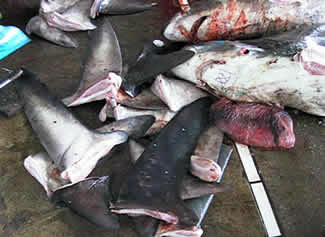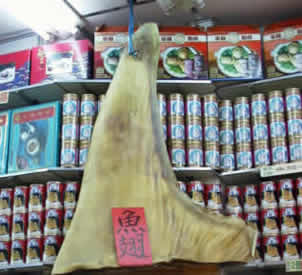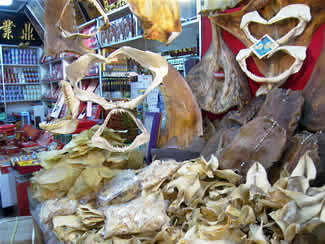
A mixture of shark fins after auction in a fish market in eastern Taiwan. photo Shelley Clarke

A "trophy" basking shark fin, not for sale, at a shop in Taipei's dried seafood market area. photo Shelley Clarke

Beneath the "trophy" basking shark fins is a display of shark fins, neatly sorted in boxes. photo Shelley Clarke

An array of shark products--jaws and fins--are available in a Taiwanese dried seafood market. photo Shelley Clarke
The first real-data study of sharks harvested for their valuable fins estimates as few as 26 million and as many as 73 million sharks are killed each year worldwide—three times higher than was reported originally by the United Nations, according to a paper published as the cover story in the October 2006 edition of Ecology Letters.
"The shark fin trade is notoriously secretive. But we were able tap into fin auction records and convert from fin sizes and weights to whole shark equivalents to get a good handle on the actual numbers," says lead author Shelley Clarke, Ph.D, an American fisheries scientist based in Hong Kong and Japan.
A team of researchers calculated the number of sharks represented in the fin trade using a unique statistical model and data from Hong Kong traders. When the figures were converted to shark weight, the total is three to four times higher than shark catch figures reported to the United Nations Food and Agricultural Organization (FAO).
"Without any real data, numbers as high as 100 million had been floating around for a while, but we had no way of knowing whether or not this was accurate," says Ellen Pikitch, Ph.D., co-author and executive director of the University of Miami's Pew Institute for Ocean Science. "This paper, which produces the first estimate based on real data, shows that the actual number of sharks killed is indeed very high but is more likely to be in the order of tens of millions, with a median estimate of 38 million sharks killed annually."
Concern about the shark finning trade has grown over the past few years as demand has surged beyond sustainable levels for slow-to-produce shark populations and without regulation in most countries. Three shark species are listed on the Convention on International Trade in Endangered Species of Wild Flora and Fauna (CITES), and 20 percent are threatened with extinction according to the 2006 Red List of Threatened Species.
Used in shark fin soup, a delicacy served at Chinese weddings and other celebrations for centuries and more recently at business dinners in Southeast Asia and the Pacific Rim, fins are the most valuable part of the shark, which typically are sliced off as the shark, sometimes still alive, is thrown back into the ocean. The shark fin trade appears to be keeping pace with the growing demand for seafood—up five percent per year in mainland China.
Determining whether shark populations can continue to withstand the magnitude of catches estimated by Clarke and her team depends upon the size and status of each population.
"One of the most productive sharks is the blue shark, and it appears that the catch rate is near the maximum sustainable level," says Clarke. "But such assessments were not available for other, less productive shark species. It is quite likely that sustainable catch levels have already been exceeded in some cases."
The United Nations FAO compiles catch records for sharks and other fish, based on information submitted from member countries. Where possible, the FAO attempts to verify the accuracy of the figures, but verification often is not practical. Many sharks may be recorded as unidentified fish and thus not be recognizable as sharks in the FAO records.
"Due to the low value of shark meat in many markets, shark fins may be the only part of the shark retained, and often these fins are not recorded in the catch log or when landed at ports. I knew we had to somehow access the major markets if we were to accurately estimate the number of sharks killed," says Pikitch, who initiated the project.
The mission of the Pew Institute for Ocean Science is to advance ocean conservation through science. Established in by a generous multi-year grant from the Pew Charitable Trusts; the Pew Institute for Ocean Science is a major program of the University of Miami's Rosenstiel School of Marine and Atmospheric Science.
